Dan Casey: Applying Ignition’s Lessons to Inertial Fusion Energy
January 10, 2024
Ever wonder how it would feel to work intensely on a challenging scientific project for a decade or more, and finally see it succeed?
Just ask Dan Casey.
When the LLNL physicist learned on the morning of Dec. 5, 2022, that the Lab’s National Ignition Facility had made history by achieving laser fusion ignition, “I was obviously elated, excited, very, very happy,” he says.
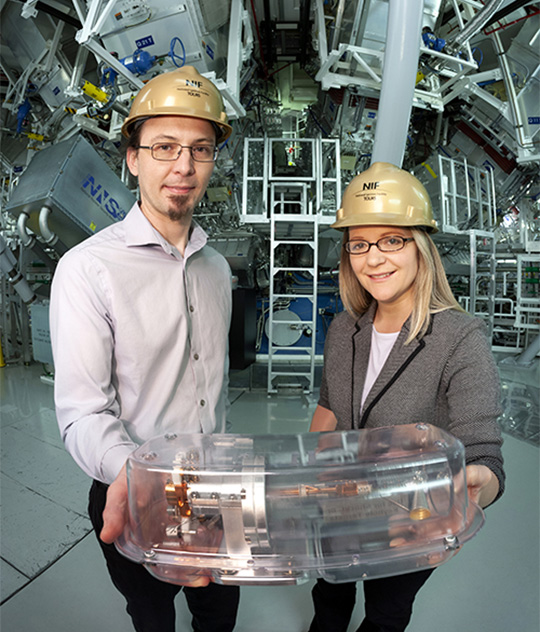 Dan Casey and Annie Kritcher, the Dec. 5, 2022, experiment’s lead designer and LLNL team lead for integrated modeling, display a NIF target in front of the Target Chamber.
Dan Casey and Annie Kritcher, the Dec. 5, 2022, experiment’s lead designer and LLNL team lead for integrated modeling, display a NIF target in front of the Target Chamber. “I was having breakfast with my son Drake. It was early in the morning because we get up super early. The shot results were probably posted a little bit earlier. I looked it up, so he was the first person I had the opportunity to talk to about it, and he’s only five years old.
“It was just a fun Sunday morning, having breakfast with your son and to be able to share something like that.”
Casey, a nuclear science and engineering graduate of the Massachusetts Institute of Technology, has been intimately involved in NIF’s effort to produce as much or more energy from an inertial confinement fusion (ICF) reaction as the laser energy delivered to the target. That’s the definition of ignition used by the National Academy of Science in a 1997 review of NIF (see “Achieving Fusion Ignition”).
Ignition was a key goal of NIF’s mission to support the National Nuclear Security Administration’s science-based Stockpile Stewardship Program to ensure the safety and reliability of the U.S. nuclear deterrent without underground testing.
And now, thanks to an award from the U.S. Department of Energy (DOE)’s Office of Science, Casey is also leveraging the knowledge gained from the decades-long pursuit of ignition to the quest for clean, safe, and abundant inertial fusion energy (IFE).
Studying Asymmetries
After a brief postdoc appointment at MIT, Casey joined LLNL’s high energy density program in 2012. He soon moved to the ICF program, working with diagnostic equipment and leading experimental campaigns for ICF-specific goals.
“In a (laser fusion) reactor system, if the targets underperform by 20 to 30 percent because of asymmetries, that means the whole system has to be bigger and more expensive.”
—Dan Casey
He now leads the program’s low-mode working group, focusing on diagnosing and assessing the impact of implosion asymmetries, which can distort NIF implosions and ultimately degrade fusion performance (an example of low-mode asymmetry is when one side of the implosion is denser than the other side).
Achieving ignition is like trying to use kindling to start a log fire, Casey says. The hot spot at the center of the target capsule is like the kindling: “We want to get and keep the hot spot hot enough to burn on its own. But that’s not really the goal.
“The goal is to get the fusion fuel in the shell around the hotspot to burn, just like getting the log to burn,” he says. When the alpha-particle radiation from the hot spot is sufficient to ignite the cold fuel surrounding the hot spot, the result is the self-sustaining thermonuclear burn known as ignition.
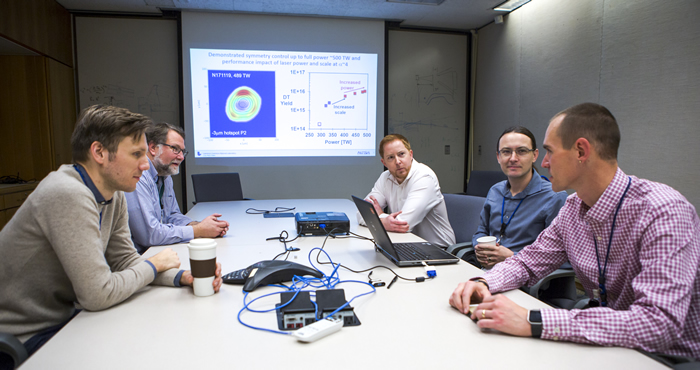 Members of the “Bigfoot” experimental team (from left): Matthias Hohenberger, Kevin Baker, Cliff Thomas, Dan Casey, and Brian Spears. Bigfoot was an experimental platform designed to control implosion symmetry and hydrodynamic instabilities, improve predictability, and enhance the delivery of laser energy to NIF’s targets. Credit: Jason Laurea
Members of the “Bigfoot” experimental team (from left): Matthias Hohenberger, Kevin Baker, Cliff Thomas, Dan Casey, and Brian Spears. Bigfoot was an experimental platform designed to control implosion symmetry and hydrodynamic instabilities, improve predictability, and enhance the delivery of laser energy to NIF’s targets. Credit: Jason Laurea “The ideal implosion would be one that is symmetric, in the sense that everything’s coming together at the same time, and that you’re pushing equally hard at all possible angles,” Casey explains. “But that’s never quite true.
“One side will be a little behind the other,” he says. “Maybe the laser was a little hot on one side relative to the other. Or there could be non-uniformities in the thickness of the target capsule.”
To better understand the causes of asymmetries, Casey worked with ICF Chief Scientist Omar Hurricane to develop an innovative “piston” model of ICF analogous to the work of mechanical pistons, such as in an internal combustion engine doing work on a gas.
“The way Omar and I abstracted this problem,” Casey says, “is to just say, ‘Okay, what if you had just two pistons that were colliding together with some gap in between them, but they weren’t quite symmetric.’
“You can get a lot of the physics from that abstraction of the asymmetry. Two stagnating pistons that are not symmetric are really very similar to what we see in ICF simulations and experiments.” They also developed a 3D piston model to further probe the physics of asymmetries.
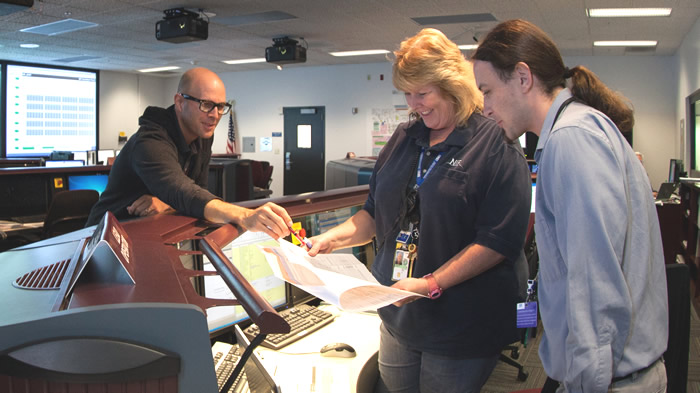 In the NIF Control Room, Dan Casey (right) joins Target Diagnostics Coordinator Mike Bolton and Beam Control work center supervisor Lisa Borrows in preparing for a high-energy ignition shot. Credit: James Pryatel
In the NIF Control Room, Dan Casey (right) joins Target Diagnostics Coordinator Mike Bolton and Beam Control work center supervisor Lisa Borrows in preparing for a high-energy ignition shot. Credit: James Pryatel “The effect on the implosion is very dramatic if one side arrives later than the other,” Casey says. “So we have a working group to study these asymmetries and to try to figure out the causes. What is their impact, and how do we fix it? We’ve been doing this for several years now, and making considerable progress.”
Casey is also involved in efforts to increase implosion compression, another possible path to even higher yields than NIF achieved in 2023 with three additional ignition experiments, including a shot in October that set a record for laser energy.
“If you can get higher compression, you can get higher yield out of the target,” he says. “It all contributes to sustaining the fusion burn for longer, and going for even more yield.”
Inspired by Spock—and Fusion
A native of Albuquerque, New Mexico, Casey developed an early love for science. “I’ve always really wanted to be a scientist,” he says. “I was a fan of Star Trek growing up; the science officer Spock was my favorite character.”
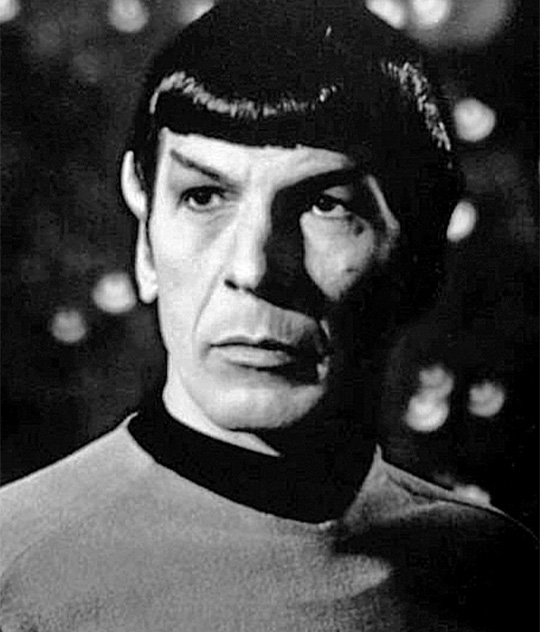 Leonard Nimoy as Star Trek’s Mr. Spock
Leonard Nimoy as Star Trek’s Mr. Spock He was also inspired by the research at nearby Sandia National Laboratories (SNL). He read about early fusion experiments on Sandia’s Z pulsed-power machine and was “fascinated with what they were doing. It planted an early seed in my head. Ever since I was very young, I found fusion exciting and interesting.”
Casey took an engineering course at a magnet school during his senior year in high school and studied nuclear engineering at the University of New Mexico. “It was this fascination of nuclear reactions and the power of these almost invisible things” that led him to work with nuclear engineering professor Gary Cooper to support a group at SNL doing yield measurements.
“Dan was wonderful to work with,” says Cooper, who focuses on nuclear diagnostics and nuclear activation measurements, including those at NIF. “I recognized his talent early in his undergraduate career and, upon discovering his interest in fusion, I hired him to support our neutron diagnostic work on the Z machine.
“Dan was like the dream student that all professors want,” Cooper says. “He was brilliant, adept at both theory and experiment, enthusiastic, always eager to tackle new projects, and possessed a demeanor and attitude that made it a pleasure to work with him beyond his intellectual talents. He was clearly one of the most productive undergraduates I ever had.”
At MIT, Casey joined the High Energy Density Physics Division at MIT’s Plasma Science and Fusion Center, led at the time by Rich Petrasso, and worked on neutron spectrometers. Part of his Ph.D. thesis was developing a novel coincidence counting method for the magnetic recoil spectrometer (MRS) diagnostic—a critical innovation that enabled the MRS to measure the faint signals associated with down-scattered neutrons, a measure of how well the capsule is compressed during an implosion.
Petrasso says he was taken aback by Casey’s eagerness to join his group even before he had a chance to “gently persuade” him to do so. “You mean, I don’t even need to convince you to join us?” he asked Casey.
“So that was how Dan joined our team,” Petrasso says. “Best decision I never made! Dan was a stellar student and stellar human being, and he added so much to the MIT team and its ambiance.”
Casey went on to become the first graduate of the NIF-MIT Ph.D.Thesis Program, which gives graduate students hands-on experience working on diagnostics, experiments, and other research at NIF, the Omega Laser System at the University of Rochester, and other partner labs. About a dozen graduates of the program have gone on to work at NIF and other ICF facilities. 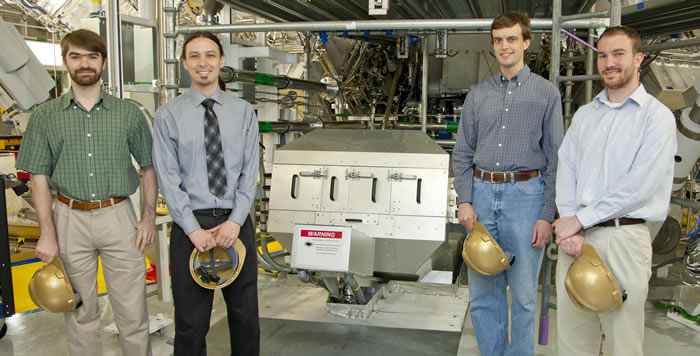 Dan Casey (second from left) with other early graduates of the NIF-MIT Ph.D. Thesis Program. In this 2015 photo in the NIF Target Chamber, Casey and fellow NIF-MIT participants Hans Rinderknecht (left), Alex Zylstra, who was chief experimentalist for the Dec. 5 ignition shot, and Mike Rosenberg stand next to a magnetic recoil spectrometer (MRS). The MRS is one of several diagnostics jointly developed for NIF by MIT’s Plasma Science and Fusion Center, the University of Rochester’s Laboratory for Laser Energetics, and LLNL.
Dan Casey (second from left) with other early graduates of the NIF-MIT Ph.D. Thesis Program. In this 2015 photo in the NIF Target Chamber, Casey and fellow NIF-MIT participants Hans Rinderknecht (left), Alex Zylstra, who was chief experimentalist for the Dec. 5 ignition shot, and Mike Rosenberg stand next to a magnetic recoil spectrometer (MRS). The MRS is one of several diagnostics jointly developed for NIF by MIT’s Plasma Science and Fusion Center, the University of Rochester’s Laboratory for Laser Energetics, and LLNL.
“Our philosophy is that every one of the students that we have here needs to be connected with an experiment out at NIF,” Petrasso says. “We’ve had a very special relationship with Livermore that goes back to the late ‘80s and early ‘90s. This is one of our critical collaborations, so important for us and for our students. It’s really worked out well.”
Advancing Fusion Energy
In 2019, Casey was recognized with a Presidential Early Career Award for Scientists and Engineers “for exceptional contributions and impressive creativity and innovation in the measurement and understanding of instability and mix for the Initial Confinement Fusion and High Density Physics Programs.” The award said he has “consistently demonstrated leadership, originality and vision.”
And in 2023 he received an Early Career Research Program (ECRP) Award from DOE’s Office of Science/Fusion Energy Sciences to apply the lessons of ICF to the burgeoning field of IFE research. In December, LLNL was named by DOE to lead the IFE Science and Technology Accelerated Research for Fusion Innovation and Reactor Engineering (STARFIRE) Hub, a four-year, $16 million project to accelerate IFE science and technology.
Both Casey’s ECRP award and the IFE-STARFIRE hub will play integral roles in the Lab’s IFE Institutional Initiative. Learning from the ECRP and the IFE-STARFIRE hub will be fed back to each other and guide the best science and technology paths forward for the Lab.
“Right now, we’re getting energy gains greater than one on NIF,” Casey says, “but an IFE system is going to need even higher gains. There are some specific IFE issues you might want to study with respect to asymmetries.
“And it’s important that we get it right, because in a (laser fusion) reactor system, if the targets underperform by 20 to 30 percent because of asymmetries, that means the whole system has to be bigger and more expensive.
“Even what seems like a small effect can add up, when you’re designing the full system, into billions of dollars,” he says. “So it’s really important that we get ahead of some of these issues and try to think about the entire reactor system in the context of what we’re learning today in these ICF experiments.“
Into the Water
Having grown up in the New Mexico desert, Casey is now drawn to water-based activities in his leisure time. “I didn’t have a body of water like the San Francisco Bay around,” he says, “so I go kayaking and boating a lot, just because I didn’t have that growing up.” He enjoys sharing those activities with his wife, Maxine, and their son Drake.
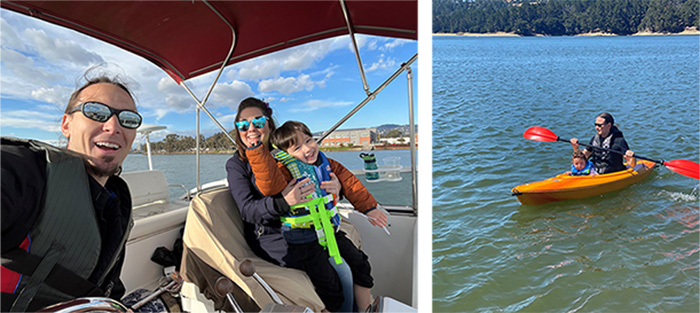 Left: Dan, Maxine, and Drake Casey enjoy an outing in San Francisco Bay. Right: Dan and Drake try their hand at kayaking. Photos courtesy of Dan Casey
Left: Dan, Maxine, and Drake Casey enjoy an outing in San Francisco Bay. Right: Dan and Drake try their hand at kayaking. Photos courtesy of Dan Casey “And we just bought a house relatively recently, so I do a lot of stuff around the house, fixing it up.”
As for his work, “I love my job,” he says, “and I love being right here at LLNL, when we are making conditions, like higher pressures that are more extreme than the center of the Sun, and watching them explode on hundreds of picosecond (trillionths of a second) timescales. There’s just so much excitement and so much to do.”
—Charlie Osolin
Follow us on Twitter: @lasers_llnl



